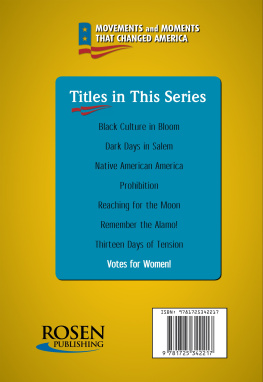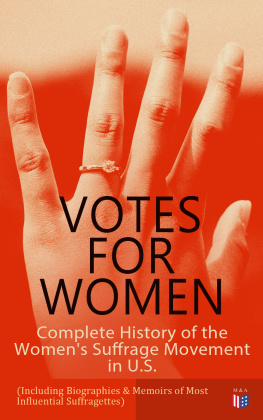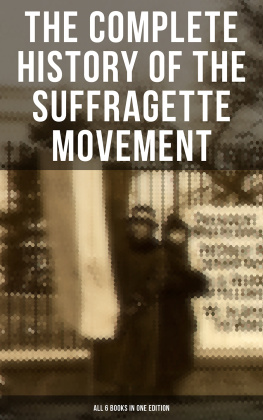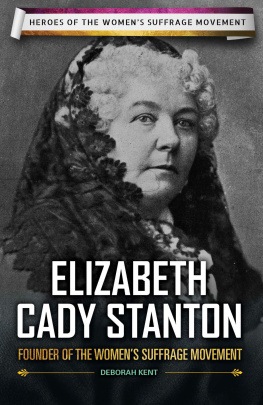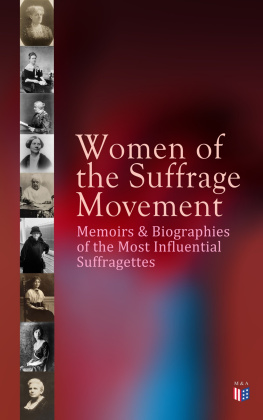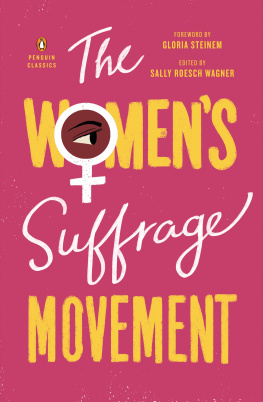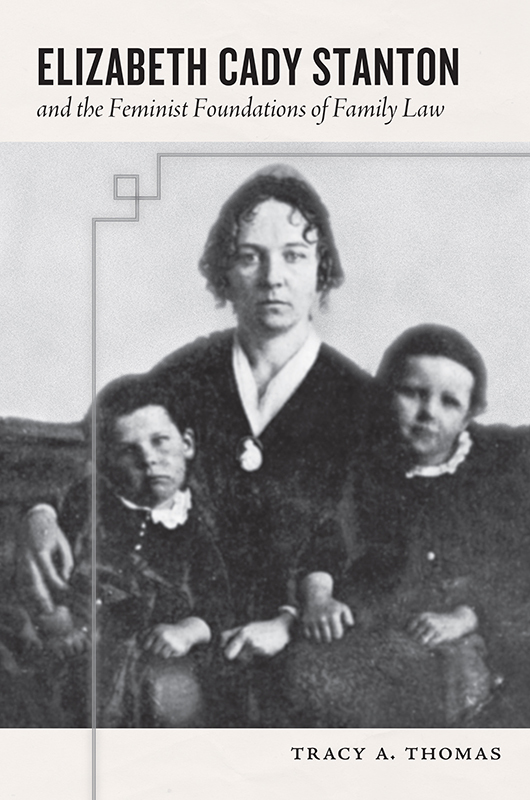
Elizabeth Cady Stanton and the Feminist Foundations of Family Law
Elizabeth Cady Stanton and the Feminist Foundations of Family Law
Tracy A. Thomas

NEW YORK UNIVERSITY PRESS
New York
NEW YORK UNIVERSITY PRESS
New York
www.nyupress.org
2016 by New York University
All rights reserved
References to Internet websites (URLs) were accurate at the time of writing. Neither the author nor New York University Press is responsible for URLs that may have expired or changed since the manuscript was prepared.
Library of Congress Cataloging-in-Publication Data
Names: Thomas, Tracy A., author.
Title: Elizabeth Cady Stanton and the feminist foundations of family law / Tracy A. Thomas.
Description: New York : New York University Press, [2016] | Also available as an ebook. | Includes bibliographical references and index.
Identifiers: LCCN 2016023899| ISBN 9780814783047 (alk. paper) | ISBN 081478304X (alk. paper)
Subjects: LCSH: Domestic relationsUnited StatesHistory19th century. | Stanton, Elizabeth Cady, 1815-1902Influence. | Feminist jurisprudenceUnited StatesHistory19th century. | Womens rightsUnited StatesHistory19th century.
Classification: LCC KF505 .T46 2016 | DDC 346.7301/5dc23
LC record available at https://lccn.loc.gov/2016023899
New York University Press books are printed on acid-free paper, and their binding materials are chosen for strength and durability. We strive to use environmentally responsible suppliers and materials to the greatest extent possible in publishing our books.
Manufactured in the United States of America
10 9 8 7 6 5 4 3 2 1
Also available as an ebook
For Mom, who gave me the wings to fly.
Contents
List of Figures
Letter from Elizabeth Cady Stanton
Elizabeth Cady Stanton, age twenty
Elizabeth Cady Stanton, Robert Stanton, and Margaret Stanton Lawrence, 1895
Portrait Monument to Elizabeth Cady Stanton, Susan B. Anthony, and Lucretia Mott, U.S. Capitol
Stanton house, Seneca Falls, New York, 2004
Stanton house, Tenafly, New Jersey
Elizabeth Cady Stanton with Henry, 1854
Statue, Stanton and Frederick Douglass, National Womens Rights Park
Victoria Woodhull and free love. Get Thee behind Me, (Mrs.) Satan! cartoon, 1872
First Day of the McFarland Trial, 1870
A Foolish Request cartoon, 1899
Elizabeth Cady Stanton with Harriot, 1856
Our Girls poster, 1875
Elizabeth Cady Stanton in Bloomer costume, 1851
Elizabeth Cady Stanton with Harriot and Nora, 1888
The Apotheosis of Suffrage cartoon, 1896
Feminists for Life flyer, c. 2007
As a young girl, I was a voracious reader of womens biography. I moved to a new school in third grade, and the librarian there introduced me to a special section of the library filled with juvenile biographies of famous women. The shelves were divided into girls biographies on the left, bound in burnt orange library covers, and the biographies of the boyhoods of famous men on the right, bound in an olive green color. When I quickly read through the smaller collection of girls books, the librarian recommended I proceed to the boys books; but I stubbornly refused. I was not interested in learning about the lives of men, and instead reread the stories of the first women scientists, doctors, authors, and artists. To this day, I have little interest in reading about the lives of men as presidents, generals, or politicians. My nightstand currently includes books on Margaret Fuller, Justice Sonia Sotomayor, Victoria Woodhull, and Georgia OKeefe. My children learned never to ask me homework questions on wars or military leaders, but astutely selected Susan B. Anthony and womens rights for school projects requiring my assistance.
As those segregated shelves so starkly illustrate, womens history has been separated from mainstream history. From elementary school libraries to the legal academy, the history of women has been considered something other than the main story. The recovery of womens history has been the first step in integrating womens experience into the accepted narrative. Scholars from history and womens studies began in the early 1970s to discover and recount the stories of women, pioneers in their fields and leaders of social movements. At the popular level, this work influenced childrens literature, which helped me line my daughters shelves with books aimed at inspiring girl power through true stories of plucky heroines. At the intellectual level, much of this recovery work remains as researchers identify not only the famous firsts but also those women who followed and were an equally important part of history and the law. For the second step of integration, scholars of womens
My intent in this book is both to recover and to integrate Stantons history into the conventional narrative of the development of family law. Along the way, the book recovers more of the stories of feminism and womens suffrage, and the family values debates that dominated the nineteenth century. I first encountered Stantons influence on family law sitting on my couch watching Ken Burnss PBS documentary on womens suffrage. I was intrigued by a few random references to Stantons work on divorce and domestic violenceand frustrated by the scant detail I could find of these assertions in the legal and historical research. As a professor of family law, I was curious about the extent to which her feminism influenced the development of this field and supremely dissatisfied by the extant knowledge. Thus a feminist legal historian was born. The resulting book is more than the story of one woman. It is the story of the lawand womens persistent appeal to the law for equal rights in the family.
Seneca Falls, March 1 [1852]
Miss Susan B. Anthony
Dear friend,
I do not know that the world is quite willing or ready to discuss the question of marriage. I feel in my innermost that the thoughts I sent your convention are true. It is in vain to look for the elevation of woman, so long as she is degraded in marriage. I say it is a sin, an outrage on our holiest feelings to pretend that anything but deep, fervent love & sympathy constitutes marriage. The right idea of marriage is at the foundation of all reforms. How strange it is, man will apply all the improvements in the arts & sciences to everything about him animate & inanimate, but himself. A child conceived in the midst of hate, sin, & discord, nurtured in abuse & injustice cannot do much to bless the world or himself. If we properly understand the science of lifeit would be far easier to give to the world, harmonious beautiful, noble, virtuous children, than it is to bring grown up discord into harmony with the great divine soul of all. I ask for no laws on marriage... remove law and false public sentiment & woman will no more live as wife with a cruel, beastly, drunkard, than a servant, in this free country will stay with a pettish, unjust mistress. If law makers insist upon exercising their prerogative in some way on this question, let them forbid any woman to marry until she is twenty one. Let them fine a woman fifty dollars for every child she conceives by a Drunkard. Women have no right to saddle the state with idiots to be supported by the public. Only look at the statistics of the idiot asylums, nearly all the offspring of Drunkards. Woman must be made to feel that the transmitting of immortal life is a most solemn responsible act & never should be allowed, except when the parents are in the highest condition of mind & body. Man in his lust has regulated this whole question of sexual intercourse long enough; let the mother of mankind whose prerogative it is to set bounds to his indulgence, rouse up & give this whole question a thorough, fearless examination.... [I]f by martyrdom I can advance my race one step I am ready for it. I feel this whole question of womans rights turns on the pivot of the marriage relation, & sooner or later it will be the question for discussion. I would not hurry it on neither would I avoid it....
Next page

